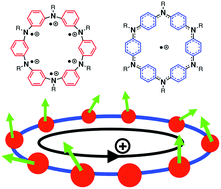Macrocyclic oligoarylamines as hole- and spin-containing scaffolds for molecule-based electronics
Abstract
Calixarenes have been widely utilized in all facets of supramolecular chemistry over the past four decades. As a new variety in the calixarene family, the nitrogen-bridged calixaromatics, namely aza[1n]cyclophanes, have been emerging as macrocyclic host molecules. However, that is not the whole picture at all: a wealth of two- and/or three-dimensionally networked molecular structures due to ortho-, meta-, and para-phenylene-bridging modes creates diverse charge distributions as well as multi-spin alignments depending on their oxidation states. This review article will provide a summary of research into the macrocyclic oligoarylamines with a variety of arene-bridged patterns and their various features as hole- and spin-containing scaffolds.

- This article is part of the themed collection: 2016 Journal of Materials Chemistry C Hot Papers

 Please wait while we load your content...
Please wait while we load your content...